阶段介绍:
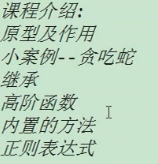
今天的内容:
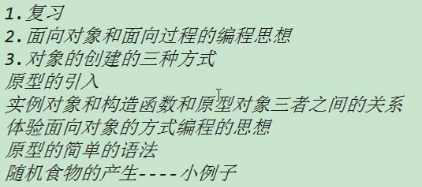
一个常识:

复习:

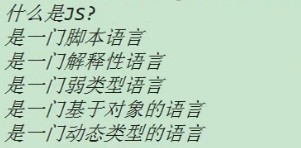


创建对象的三种方式:


1 <!DOCTYPE html> 2 <html lang="en"> 3 <head> 4 <meta charset="UTF-8"> 5 <title>这是网页的标题</title> 6 </head> 7 <body> 8 9 <script src="js/common.js"></script> 10 <script> 11 // 1 使用字面量的方式 12 var person1 ={ 13 name:"tom", 14 age:18, 15 eat:function () { 16 console.log("我爱吃东西"); 17 } 18 }; 19 //2 使用系统的构造函数 20 var person2 = new Object(); 21 person2.name = "alex"; 22 person2.age = 30; 23 person2.eat =function () { 24 console.log("我爱吃饭!"); 25 }; 26 //3 自定义构造函数 27 function Person(name, age) { //当名字是大写的时候就是类,小写的时候是函数 28 this.name = name; 29 this.age = age; 30 this.eat = function () { 31 console.log("我爱吃面!"); 32 }; 33 } 34 var person3 = new Person("tom",18); 35 console.log(person3 instanceof Person); 36 37 </script> 38 </body> 39 </html>
第三种用的最多,也是最方便的方式。
自定义构造函数 创建对象做的事情:
创建对象,也成实例化。
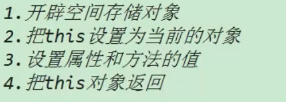
工厂方式创建对象:

1 <!DOCTYPE html> 2 <html lang="en"> 3 <head> 4 <meta charset="UTF-8"> 5 <title>这是网页的标题</title> 6 </head> 7 <body> 8 9 <script src="js/common.js"></script> 10 <script> 11 //工厂方式创建对象 factory pattern 12 //通过工厂方式创建对象 13 function createObjByFactoryPattern(name,age) { 14 var obj = new Object(); 15 obj.name = name; 16 obj.age = age; 17 obj.eat = function () { 18 console.log("我爱吃饭"); 19 }; 20 return obj; 21 } 22 var p1 = createObjByFactoryPattern("tom",18); 23 </script> 24 </body> 25 </html>
工厂方式创建对象 和自定义构造函数方法创建对象 的区别:

1 <!DOCTYPE html> 2 <html lang="en"> 3 <head> 4 <meta charset="UTF-8"> 5 <title>这是网页的标题</title> 6 </head> 7 <body> 8 9 <script src="js/common.js"></script> 10 <script> 11 //工厂方式创建对象 factory pattern 12 //通过工厂方式创建对象 13 function createObjByFactoryPattern(name,age) { 14 var obj = new Object(); 15 obj.name = name; 16 obj.age = age; 17 obj.eat = function () { 18 console.log("我爱吃饭"); 19 }; 20 return obj; 21 } 22 //自定义构造函数方式 创建对象 23 function Person(name, age) { 24 this.name = name; 25 this.age = age; 26 this.eat = function () { 27 console.log("我爱吃饭"); 28 }; 29 } 30 31 32 33 </script> 34 </body> 35 </html>

注:我们一般都是使用自定义函数的方式来创建对象。其实可以将其理解为一个类,这里下面称之为类。
类(借用其他语言概念)和实例对象的关系:

是先有类,再有类的。
补:console.dir(obj) 可以将obj 的结构显示出来。

1 <!DOCTYPE html> 2 <html lang="en"> 3 <head> 4 <meta charset="UTF-8"> 5 <title>这是网页的标题</title> 6 </head> 7 <body> 8 9 <script src="js/common.js"></script> 10 <script> 11 function Person(name,age) { 12 this.name = name; 13 this.age =age; 14 this.eat = function () { 15 console.log("我爱吃东西!"); 16 }; 17 } 18 var p = new Person("tom",18); 19 console.dir(p); 20 console.dir(Person); 21 22 console.log(p.constructor == Person); //true 说明 p的构造器是 Person . 23 console.log(p.__proto__.constructor == Person); //true 24 console.log(p.__proto__.constructor == Person.prototype.constructor) //true 25 26 27 console.log(Person.prototype.constructor == Person); //true ,说明Person的构造器是它自己。 28 29 30 31 32 </script> 33 </body> 34 </html>
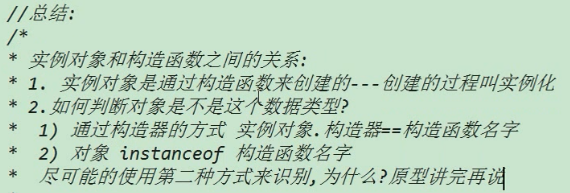
上面说的 构造函数也可以理解为 类。
原型prototype:
自定义构造函数创建对象带来的问题:
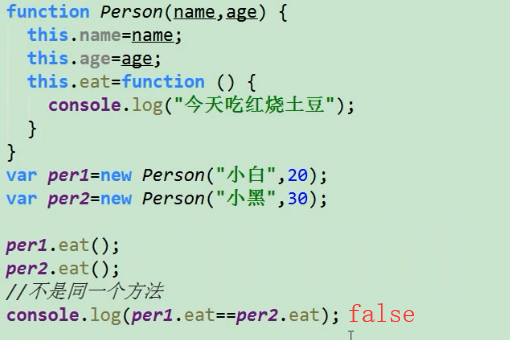
此时,如果这些方法都是完全相同的,这样就会浪费很多的内存空间。
此时也可以通过console.dir() 查看per1 和 per2的结构,如下图:
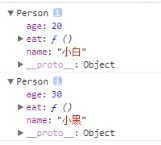
可以通过下面有名函数方式解决。

1 <!DOCTYPE html> 2 <html lang="en"> 3 <head> 4 <meta charset="UTF-8"> 5 <title>这是网页的标题</title> 6 </head> 7 <body> 8 9 <script src="js/common.js"></script> 10 <script> 11 function func() { 12 console.log("我爱吃东西"); 13 } 14 15 function Person(name,age) { 16 this.name = name; 17 this.age =age; 18 this.eat = func; 19 } 20 var p1= new Person("tom",18); 21 var p2= new Person("egon",45); 22 console.log(p1.eat == p2.eat ); //此时是 true 23 24 25 26 27 </script> 28 </body> 29 </html>
可是,这种方式并不好,容易造成命名冲突的问题。
如下代码所示的命名冲突:

1 <!DOCTYPE html> 2 <html lang="en"> 3 <head> 4 <meta charset="UTF-8"> 5 <title>这是网页的标题</title> 6 </head> 7 <body> 8 9 <script src="js/common.js"></script> 10 <script> 11 function func() { 12 console.log("我爱吃东西"); 13 } 14 func = 15; //造成了命名冲突 15 function Person(name,age) { 16 this.name = name; 17 this.age =age; 18 this.eat = func; 19 }; 20 var p1= new Person("tom",18); 21 var p2= new Person("egon",45); 22 console.log(p1.eat == p2.eat ); //此时是 true 23 24 25 26 27 </script> 28 </body> 29 </html>
那么问题来了,该如何解决呢?
此时就要用到原型了。
原型 作用之一 就是用来解决 数据共享,节省内存空间 这种问题的。
以上就是原型的引入。
原型的使用:

1 <!DOCTYPE html> 2 <html lang="en"> 3 <head> 4 <meta charset="UTF-8"> 5 <title>这是网页的标题</title> 6 </head> 7 <body> 8 9 <script src="js/common.js"></script> 10 <script> 11 function Person(name,age) { 12 this.name = name; 13 this.age =age; 14 } 15 //通过 原型(prototype )来添加方法 ,可以实现数据共享,节省内存空间。 16 Person.prototype.eat = function () { 17 console.log("我爱吃东西!"); 18 }; 19 var p1= new Person("tom",18); 20 var p2= new Person("egon",45); 21 console.log(p1.eat == p2.eat ); //此时是 true 22 23 //查看 两个对象的结构 24 console.dir(p1); 25 console.dir(p2); 26 27 </script> 28 </body> 29 </html>
原型它其实是将方法放到了 构造函数Person.prototype中了。
Person 作为他们的类,为他们共有。

1 <!DOCTYPE html> 2 <html lang="en"> 3 <head> 4 <meta charset="UTF-8"> 5 <title>这是网页的标题</title> 6 </head> 7 <body> 8 9 <script src="js/common.js"></script> 10 <script> 11 function Person(name,age) { 12 this.name = name; 13 this.age =age; 14 } 15 //通过 原型(prototype )来添加方法 ,可以实现数据共享,节省内存空间。 16 Person.prototype.eat = function () { 17 console.log("我爱吃东西!"); 18 }; 19 var p1= new Person("tom",18); 20 var p2= new Person("egon",45); 21 console.log(p1.eat == p2.eat ); //此时是 true 22 23 24 console.dir(p1); 25 console.dir(p2); 26 console.dir(Person); 27 //p1 和 p2的 eat 方法,都是在 Person.prototype中的。 28 29 </script> 30 </body> 31 </html>
总结:可以将 相同的方法,放入到Person.prototype (类属性中),以达到节省空间的目的。
实例对象的proto是有 下划线的,类对象没有。
体会面向过程和面向对象的编程思想:
点击按钮,改变div 的背景颜色:

1 <!DOCTYPE html> 2 <html lang="en"> 3 <head> 4 <meta charset="UTF-8"> 5 <title>这是网页的标题</title> 6 <style> 7 div{ 8 width: 300px; 9 height: 400px; 10 background-color: darkred; 11 } 12 </style> 13 </head> 14 <body> 15 <input type="button" value="点击" id="btn"> 16 <div id="dv"></div> 17 <script> 18 //点击按钮,改变div 的背景颜色 19 document.getElementById("btn").onclick = function () { 20 document.getElementById("dv").style.backgroundColor = "yellow"; 21 }; 22 </script> 23 </body> 24 </html>
